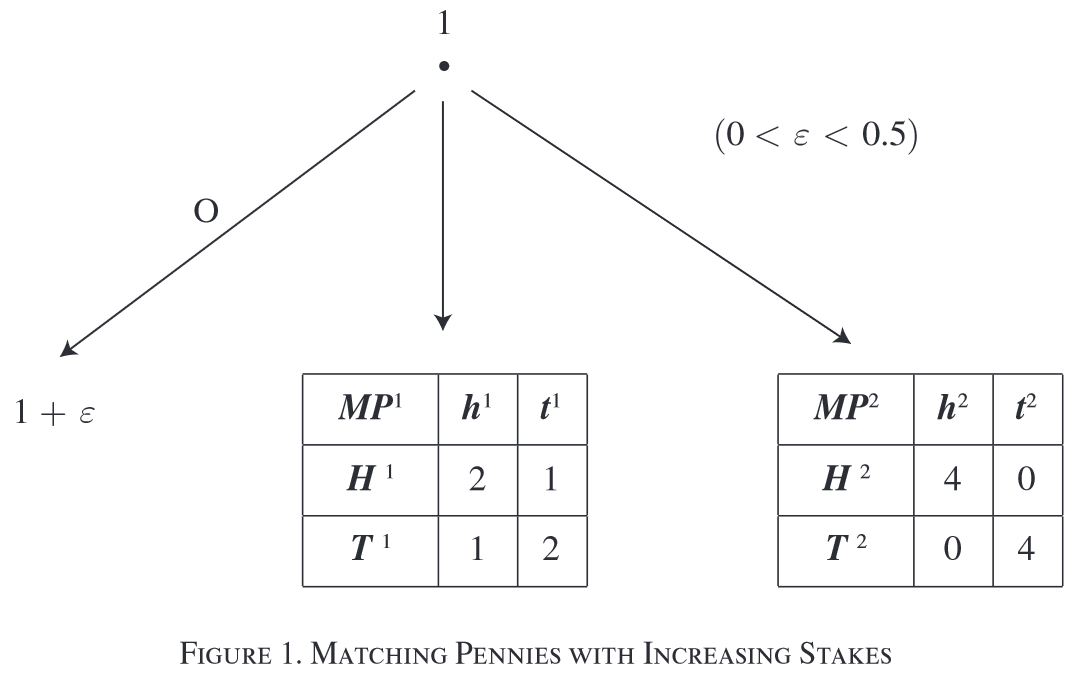INFO
💡 This paper extended the traditional SCE model to insert ambiguity aversion and find that ambiguity aversion enlarges the set of SCE. The intuition is that the aversion to payoffs with unknown distributions mitigates the potential “experimentation“ of other alternative strategies, and thus makes decision-makers stick to the former path.
Setting
A randomly matched society. Use large populations (or Nash’s mass action) scenario: many individuals play the game
Learning issue: Misbeliefs in SCE and Partial Identification. Many underlying distributions are possible to explain the empirical frequencies they observe (i.e. patterns learned from evidence). Players use accumulated evidence as dataset to evaluate the outcome distribution associated with each choice. There is intrinsic limitations to the available evidence: can only know the terminal node of the sequential game, and mostly his own payoff instead of others’.
Ambiguity in Opponents’ strategies. Players cannot infer the distribution of strategy profiles adopted by the opponents, because it is not possible to know from the long-run frequency stats, which thus results in the fundamental inference problem.
Objective and Subjective uncertainty
For state-space
Utility under Ambiguity. do not use the maxmin utility function
Smooth SCE
Agents in each role best respond to beliefs consistent with their database, choosing actions with the highest smooth ambiguity value, and their database is the one that obtains under the true data generating process corresponding to the actual strategy distribution
An Example
Player 1 chooses between an outside option
- Subgame
has higher maxmin stakes than (maxmin value ) - Calculate the maxmin value: in
the distribution that minimize the expected payoff is , in which the highest payoff (maxmin value) is 2. Similarly, maxmin value in is 1.5.
- Calculate the maxmin value: in
- only one Bayesian SCE: Player 1 always choose
due to a higher maxmin value and one half of players play - sub prob of P1: assign probability to the choice
as , and - subjective value:
in and in - However, the value of
is , which is lower than other two Games
- subjective value:
What Subgames are reachable?
- For an ambiguity neutral agent, neither
nor can happen in a Bayesian SCE - in a repeated game. even if they are in
or , they can learn and turn to
- in a repeated game. even if they are in
- Ambiguity aversion makes
or reachable through status quo bias - For agents already in
with moderate ambiguity aversion, the aversion to unknown payoff in case makes its payoff penalized, so people still stay in - High ambiguity aversion makes the option
also possible since people in do not want to suffer from ambiguity in both games. For an extreme case, the agent see obj payoff in as the lowest payoff 1 and as the lowest payoff 0, which are less than
- For agents already in

Recurrent Games and Self-Confirming Equilibrium
Games with Feedback
a game form with feedback has the form:
is the set of player roles is the finite set of strategies of , and let and denote the set of all strategy files and player ’s opponents’ strategies is a set of messages that player may receive at the end of the game - Feedback function:
. If the game is dynamic, a player’s feedback is a function of the terminal node reached under strategy profile . In this case, where is the extensive-form feedback function for player .
Example 1: Three cases about the forms of Feedback
each player observes the terminal node (reached under the realized strategy profile). That is, is the identity on each player observes everybody’s material consequences at the terminal node, that is, is the consequence function each player observes his own material consequences at the terminal node, that is, is the projection of
The player infer that the strategy profile played by his opponents must belong to the set
Rewrite:
Example 2: in former game, player 1 observes only his monetary payoff
the ex post information partition:
Note. A game form with feedback
Players' Preferences
For
Call game with feedback the tuple
Ambiguity Aversion (KMM smooth ambiguity criterion)
ambiguity attitudes in population i are represented by a strictly increasing and continuous function
KMM smooth ambiguity criterion is
- player
is uncertain about the true distribution of strategies in the population of potential opponents - measure of ambiguity aversion:
von-Neumann Utility in KMM
standard Bayesian SEU in KMM
robust criterion Gilboa and Schmeidler